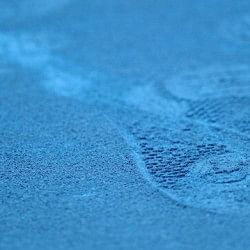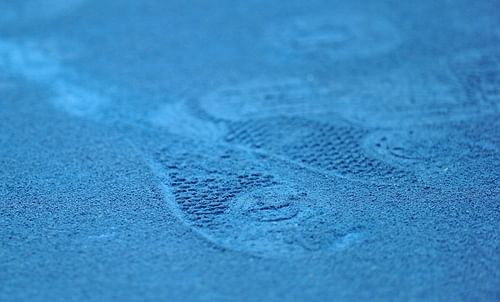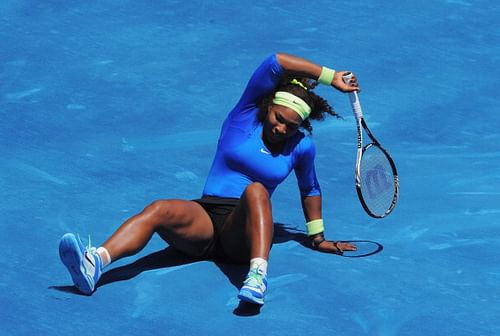
Missing the blue clay - An innovation which was worth watching

When Roger Federer begins his title defense at Madrid come Wednesday, the 2012 champion would be left wondering if he did win a tournament here last May, judging by the colour of the clay. It was just last year that the court was tested with blue coating, a move proposed by Ion Tiriac – the owner of Madrid event – and has been immediately brought back to its original look this season, following players’ refusal to vouch for their participation. Most of the players, including Djokovic and Nadal, were complaining about the slippery nature of the blue clay which could pose serious injury threats to them. In the end, Tirioc had to accede to the appeals of the players by providing them with the red dirt all over again.
That was a surprise contention by the players because it was told that the surface was made up of the same components with which they used to prepare the normal red clay. In fact, better visibility of the balls for the TV viewers was cited as the prime reason behind the change. If that was the case, then what prompted the players to protest against this innovation? May be the tour organizers chose to hide a few facts with regards to the blue clay and that could be a reason why players were enraged at being asked to play on a surface which did not look convenient to them. All said and done, the Masters event was successfully completed for the first time on blue clay and, more importantly, no one was injured in the process.
Tennis is a very physically demanding sport and hence injury troubles should be viewed as part and parcel of the game. No matter how hard you have trained, it is extremely difficult to ensure an injury-free career considering the busy nature of the tennis calendar which extends beyond 10 months every year. So, just a week long outing on blue clay should not be construed as a serious threat to a star’s career. They are professionals, after all, who should learn to adjust themselves to unfriendly circumstances.
So, should we blame the players for the failure of the trial version brought in last year? Should we say that the players have over-reacted by expressing their unhappiness on the playing surface too soon? To be honest, the players have every right to choose what surface they should be playing on and it is wrong to thrust something upon them.
Most of the clay courts are made of red colour, constructed by crushed bricks. Traditionally, all the clay court Masters plus the French Open at Roland Garros have been played only on the red soil – till last year of course, when the courts in Madrid were painted blue. There also green clay courts (American Clay) which we have been seeing regularly in a WTA event called Family Circle cup. If you have been following US Men’s clay court championships, then you would have seen the maroon-coloured surface too. So, when there are so many varieties of coloured clay courts, accepted by the players of both the sexes, it needs to be addressed why blue clay alone was forced to be withdrawn just one year after its implementation and why the players were not interested in taking it forward.

When you try finding out the reason for the flop show of blue clay, you would become absolutely sure that the players were not at fault at all. The problem occurred only due to the high-handedness of the ATP and also, to an extent, due to the hastiness of the tour owner who implemented the change quite hurriedly. The changes had been brought forth by them without properly consulting the players and that led to the whole debacle, to be precise.
Even before the commencement of the Madrid Masters on blue clay, both Djokovic and Nadal had their doubts with regards to the newly laid surface. Nadal expressed his dissatisfaction about this then unknown territory and was quoted saying, “There can’t be too much difference between Madrid and Rome.”
The Masters at Madrid and Rome have been played one after the other and so the Spaniard did not like the idea of turning up on two different surfaces in the space of couple of weeks. The current world No.1, Novak Djokovic, was even more vocal and pointed fingers at the ATP for not listening to the players on such critical issues, though he agreed that changes were needed to make the game more interesting.
This is what he had to say, “As far as I know, most of the top players I talked to, nobody agreed. I never played on blue clay. Rafa didn’t. Roger (Federer) didn’t. If you don’t have the top players agreeing on that, it doesn’t make sense for me really,” Djokovic said.
He further said, “It’s going to be interesting to step on the blue clay obviously. I’m not blaming them … But definitely there is a certain rule within the ATP that the president is able to make decisions by himself without having players agree to that.” He finished saying, “That rule has to be changed because it’s not fair.”
Novak was spot-on when he said that the players were taken for granted and were not properly heard.
Was it right on the part of ATP, or for that matter WTA, to forgo the interests of the players before taking such a stand? This was where, I believe, the organizers missed a trick or two. Had they gained the confidence of the players before disclosing the facts about the surface, the blue clay would have been a big success and would have continued even this year too. No one is or was against innovation. And why would they be anyway? All innovations are going to spark the interests of the players and also the audience. Only when there are mis-communications and non disclosure of facts do the innovations and inventions turn hostile.
Even though that it did not go down well with the players, “Blue Clay” was loved by most of the spectators. The oddity of the surface increased the eagerness of the fans and the look of the colour had them spell-bound. Had the surface been corrected – regardless of the colour – in consensus with the players – this Masters event would have become a bigger hit in the tennis calendar in the future.